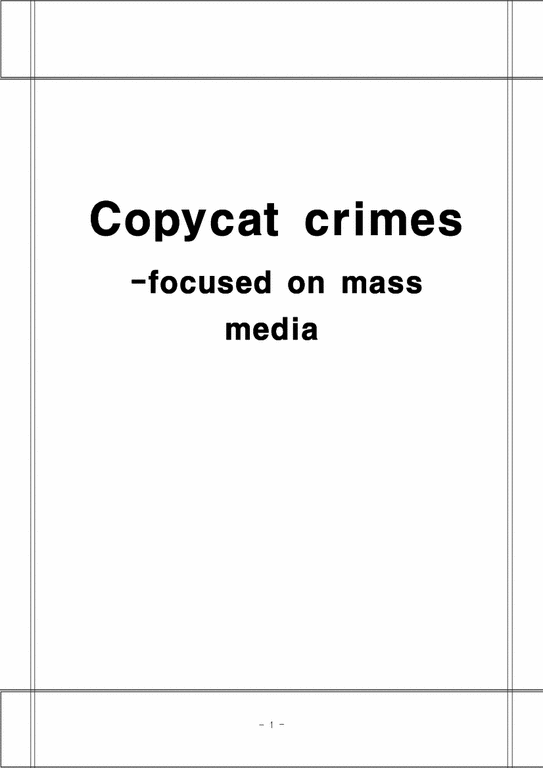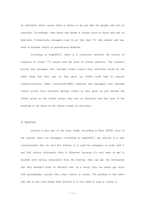Copycat crimes(모방범죄) -매스디미어
 등록일 / 수정일
등록일 / 수정일 페이지 / 형식
페이지 / 형식 자료평가
자료평가 구매가격
구매가격
- 2010.01.27 / 2019.12.24
- 16페이지 /
 hwp (아래아한글2002)
hwp (아래아한글2002) - 평가한 분이 없습니다. (구매금액의 3%지급)
- 1,200원
최대 20페이지까지 미리보기 서비스를 제공합니다.
자료평가하면 구매금액의 3%지급!
 1
1 2
2 3
3 4
4 5
5 6
6 7
7 8
8 9
9 10
10 11
11 12
12 13
13 14
14 15
15 16
16
추천 연관자료
- 목차
-
Ⅰ. Introduction
Ⅱ. Definition of copycat crimes
Ⅲ. Procedure
Ⅳ. Description of Findings and Analysis
A. The Psychology of Copycat Crime
1. Bandura’s Bobo doll experiment
2. Applications of Bobo Experiment to Multimedia
B. Environmental Factors Encouraging Copycat Crimes
1. TV
2. Internet
3. Game
C. Solutions
Ⅴ. Bibliography
- 본문내용
-
There are main environmental factors that make teenagers commit copycat crimes. First, TV could encourage teenagers to commit crimes. Because teenagers tend to act like people on TV, they could imitate violent behavior and crimes from TV. Second, unsuitable information from Internet like pornography and suicide club could have a bad influence on teenagers. It would lead teenagers to do violent acts. Finally, killing and shooting games cause teenagers to do aggressive actions in real life.
To make copycat crimes, governmental solutions and educational solutions are needed. First of all, government should control the media's crime scenes and violent scenes. Pre-censorships and post-censorship of mass communication would be necessary. Second, appropriate media education should be offered. They will help people use and consume media in a the proper way(Jang, 2007).
Compared to the past a lot more violent media contents are flooding our society and accordingly copy cat crimes are also emerging as a serious social problem. Especially, mass media has a great influence on teenagers. According to Park (2009), mass communication is largely responsible for teenage crimes. For example, movies with violent scenes on television encourage teenagers to do copycat crimes. As a result, when they keep watching the violent scenes in the long term, they get insensitive to criminal acts.
- 참고문헌
-
Balk, D.E. (1995). Adolescent development: Early through late adolescence. Brooks/Cole Publishing Company.
Bandura, A and Richard H. W.(1963) Social learning and personality development. New York: Holt, Rinehart and Winston.
Centerwall, B.S. (1992). Television and violence: The scale of the problem and where to go from here. Journal of the American Medical Association, 267(22), 3059-3063.
Champion, D.J. (2004). The American Dictionary of Criminal Justice: Key Term: Key Major Court Cases. California: Roxbury Publishing Company.
Comstock, G. (1986). Television and film violence. In S. J. Apter & A. P. Goldstein(Eds.), Youth and violence: Programs and prospects(pp. 178-218). NY: Pergamon Press.
Eron, L. D. (1982). Parent-child interaction, television violence, and aggression of children. American Psychologist, 37, 197-211.
Jang H.S. (2007). The effects of mass media. Adolescent Psychology (pp.351-516). Seoul: Park Young Sa.
Lee S.Y. (2000). Internet and adolescent's consciousness of sex. Intelligence and society, 2, 154-182.
Min, H.D. (2008). A Study on the Causes of Copycat Crimes - Focused on the Effects of Media. The Korean Society of Private Security
Nam Y.O. & Lee S.J. (2002) The research of adolescent's cyber sex addiction and the relationship between cyber pornographic internet content and sex. The research of teenagers, 9(3), 185-212
Oh J.Y & Jung J.E (2008). Privacy of child [Television series episode]. In Kim M.T, Morality. Seoul: Educational Broadcasting system.
Park S.K. (2009). Mass media and crime. Criminal Policy, 10, (pp.271-514). Seoul: Korean Criminal Policy Researcher.
Shuttleworth, M (2008) .Bobo Doll Experiment. Retrieve 2008, from http://www.experiment-resources.com/
Wikipedia. (2009). Copycat crimes. Retrieve October 22, 2009, from http://en.wikipedia.org/wiki/Copycat_crimes
Young, K. S. (2009, August 15). Internet addiction: Cyber sex / cyber porn. The Center for Internet Addiction. Retrieved October 29, 2009, from http://netaddiction.com/index.php
Zimbardo, G.(2009). Psychology and life. Pearson. 199-202
자료평가
-
아직 평가한 내용이 없습니다.
오늘 본 자료
더보기

최근 판매 자료
- 긍정심리학 - 통합적 설명모델을 기반으로 현재 나의 삶의 만족과 행복에 관해 설명하기
- [의료화현상]의료화 현상의 의미를 각각의 사례와 함께 설명한 뒤 이러한 현상이 나타나게 된 배경과 의료화 현상에 대한 논의의 의의에 대해 서술
- 국제개발협력 프로젝트의 성공과 실패 사례연구 조사보고서 작성 제출
- 객관적 질문지 검사의 특징과 해당되는 검사에 대해 서술해 봅시다
- [한국정치의 이해]우리나라 정부형태(대통령제)의 문제점과 해결방안
- 보육과정의 철학적 기초에 대한 내용을 정리하고_ 예비 보육교사로서 가장 중요하게 생각하는 보육과정의 철학적 기초는 무엇인지 근거를 들어 기술하세요
- 사회복지정책에서 1) 보편주의와 선별주의에 대해 각각 설명하고 2) 현재 시행 중인 사회복지정책제도를 하나 선택하여 간락히 소개해주세요 3) 이 제도를 보편주의 또는 선별주의와 연결하여 설명해주세요.
- 국세부과 제척기간과 국세징수권 소멸시효에 대해 비교 서술하시오
- [공공경제] 외부불경제와 정부실패
- 정치적 위험의 개념, 원인, 유형, 관리를 설명, 정치적 위험과 국가적 위험을 비교 설명
저작권 관련 사항 정보 및 게시물 내용의 진실성에 대하여 레포트샵은 보증하지 아니하며, 해당 정보 및 게시물의 저작권과 기타 법적 책임은 자료 등록자에게 있습니다. 위 정보 및 게시물 내용의 불법적 이용, 무단 전재·배포는 금지됩니다. 저작권침해, 명예훼손 등 분쟁요소 발견시 고객센터에 신고해 주시기 바랍니다.









